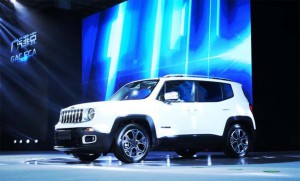The first locally made Jeep Renegade SUV began rolling down the assembly line in Guangzhou, China, this week, marking a critical step in parent Fiat Chrysler Automobile’s bid to get a foothold in the world’s largest automotive market.
A weak presence in China is one of the reasons why FCA CEO Sergio Marchionne said the automaker needs to find a partner. The irony is that Jeep – then owned by American Motors – was the first foreign automaker to set up a Chinese manufacturing venture. But it lost that operation following the break-up of the ill-fated DaimlerChrysler AG nearly a decade ago.
FCA spent a number of years trying to negotiate Jeep’s return to production in China, just launching its first new plant there last October. The Changsha facility currently produces the bigger Jeep Cherokee model.
“Today is an important step in our strategy to expand the Jeep brand’s global presence and, equally important, it represents a further strengthening of the joint enterprise with our respected and valuable partner here in China, the GAC Group.”
(FCA not likely done pursuing mergers. For more, Click Here.)
Under Chinese law, foreign automakers cannot operate independently, but must instead partner with local manufacturers. Fiat Chrysler teamed up with GAC Group in what is known as the GAC Fiat Chrysler Automobiles Co., Ltd, or GAC FCA.
The launch of the two new Jeep plants come at a critical time. While Chinese car sales have slowed over the last 18 months, it is still the world’s largest automotive market, and demand for SUVs has been growing rapidly. China is expected to become Jeep’s single-largest market outside the United States.
The Renegade plant in Guangzhou is expected to produce as much as 160,000 vehicles annually. That would make that one factory alone a critical piece in Jeep’s global growth strategy. It is targeting worldwide sales of 1.9 million by 2018, up from just 800,000 as recently as 2013.
To get there, Jeep plans to add a number of new products, the Renegade just the latest, but others including a full-size ute and a pickup, now under development. Jeep will ultimately operate 10 plants in a global network, including facilities in not only China but also India, Brazil and India, as well as another country yet to be named. In 2013, it had four plants, all based in the U.S.
(Click Here for details about the new Jeep Grand Cherokee models.)
The two Chinese Jeep plants were designed to adopt FCA’s World Class Manufacturing system, a process aimed at improving productivity while also reducing waste and eliminating quality snags.
The launch of Cherokee production last October marked a significant milestone for FCA, CEO Marchionne launching an exhaustive search for a partner in the booming Chinese market soon after Fiat took control of Chrysler in 2010.
Ironically, it actually marked a return to the Asian market for Jeep, which opened the groundbreaking Beijing Jeep plant in 1985, after almost a decade of negotiations.
The SUV brand was owned by the former American Motors at the time, AMC being purchased by Chrysler Corp. a few years later. The operation was renamed Beijing Benz-DaimlerChrysler Automotive Co Ltd in 2004, with several Mercedes-Benz models moving into the factory. The production of all Chrysler products ended by 2008, and the operation was shifted to the German side with the subsequent break-up of DaimlerChrysler.
(To see more about the move to build the Jeep Compass/Patriot replacement in Brazil, Click Here.)
That left Chrysler, and then FCA, without a local production base in China, a serious challenge due to the hefty taxes on automotive imports. The two new Jeep operations are expected to help lower the cost of the brand’s Renegade and Cherokee models and deliver a big bump in sales.


